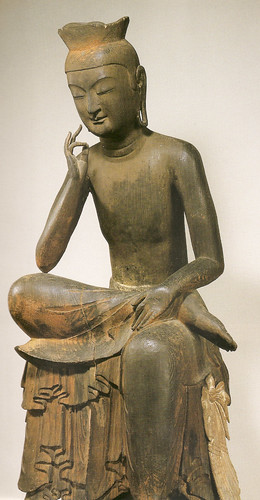.
 MAITREYA is said to be the future Buddha, the successor to the historic Shakyamuni Buddha. It's said that his 'coming' may happen today, or perhaps in a few thousand (or perhaps millions) of years. In the meantime, he awaits his return, residing in Tushita Heaven. Yes, there are some elements to Maitreya rather like the 'Second Coming' of Jesus. Maitreya is taken by many as something like a Buddhist Messiah.
MAITREYA is said to be the future Buddha, the successor to the historic Shakyamuni Buddha. It's said that his 'coming' may happen today, or perhaps in a few thousand (or perhaps millions) of years. In the meantime, he awaits his return, residing in Tushita Heaven. Yes, there are some elements to Maitreya rather like the 'Second Coming' of Jesus. Maitreya is taken by many as something like a Buddhist Messiah.
He is often seen seated in a pose somewhat reminiscent of Rodan's "THE THINKER", but with softer shape and expression, sometimes tranquil and sometimes crying, contemplating the suffering of sentient beings. In fact, Maitreya's name may be derived from the Sanskrit word Maitri (Metta in Pali), 'loving-kindness'.
Sometimes he is seen in this form ...

... perhaps from after he let himself go. However, the origins of this popular "Laughing Buddha" are actually found in a figure called Hotei from China, a jolly fat monk who happened to be a devotee of Maitreya, and whose image became mixed into the Maitreya legend over time. In any event, even if not really "Maitreya", the image is very popular in Chinese Buddhist temples ... and Chinese restaurants. One popular belief is that if one rubs his fat belly on the 1st day of the Lunar Year, it will bring forth wealth, good luck and prosperity.
However, the origins of this popular "Laughing Buddha" are actually found in a figure called Hotei from China, a jolly fat monk who happened to be a devotee of Maitreya, and whose image became mixed into the Maitreya legend over time. In any event, even if not really "Maitreya", the image is very popular in Chinese Buddhist temples ... and Chinese restaurants. One popular belief is that if one rubs his fat belly on the 1st day of the Lunar Year, it will bring forth wealth, good luck and prosperity.
(In my case, I typically think of the Laughing Buddha when I break my diet ... often at a Chinese restaurant.)
Maitreya was frequently taken as a cult symbol driving peasant rebellions and other mass movements for social change or revolution in China in centuries past.
In so many ways, Maitreya is simply a symbol of future hope and change.
Today’s Sit-A-Long video follows at this link. Remember: recording ends soon after the beginning bells; a sitting time of 15 to 35 minutes is recommended.
 MAITREYA is said to be the future Buddha, the successor to the historic Shakyamuni Buddha. It's said that his 'coming' may happen today, or perhaps in a few thousand (or perhaps millions) of years. In the meantime, he awaits his return, residing in Tushita Heaven. Yes, there are some elements to Maitreya rather like the 'Second Coming' of Jesus. Maitreya is taken by many as something like a Buddhist Messiah.
MAITREYA is said to be the future Buddha, the successor to the historic Shakyamuni Buddha. It's said that his 'coming' may happen today, or perhaps in a few thousand (or perhaps millions) of years. In the meantime, he awaits his return, residing in Tushita Heaven. Yes, there are some elements to Maitreya rather like the 'Second Coming' of Jesus. Maitreya is taken by many as something like a Buddhist Messiah.He is often seen seated in a pose somewhat reminiscent of Rodan's "THE THINKER", but with softer shape and expression, sometimes tranquil and sometimes crying, contemplating the suffering of sentient beings. In fact, Maitreya's name may be derived from the Sanskrit word Maitri (Metta in Pali), 'loving-kindness'.
Sometimes he is seen in this form ...

... perhaps from after he let himself go.
 However, the origins of this popular "Laughing Buddha" are actually found in a figure called Hotei from China, a jolly fat monk who happened to be a devotee of Maitreya, and whose image became mixed into the Maitreya legend over time. In any event, even if not really "Maitreya", the image is very popular in Chinese Buddhist temples ... and Chinese restaurants. One popular belief is that if one rubs his fat belly on the 1st day of the Lunar Year, it will bring forth wealth, good luck and prosperity.
However, the origins of this popular "Laughing Buddha" are actually found in a figure called Hotei from China, a jolly fat monk who happened to be a devotee of Maitreya, and whose image became mixed into the Maitreya legend over time. In any event, even if not really "Maitreya", the image is very popular in Chinese Buddhist temples ... and Chinese restaurants. One popular belief is that if one rubs his fat belly on the 1st day of the Lunar Year, it will bring forth wealth, good luck and prosperity.(In my case, I typically think of the Laughing Buddha when I break my diet ... often at a Chinese restaurant.)
Maitreya was frequently taken as a cult symbol driving peasant rebellions and other mass movements for social change or revolution in China in centuries past.
In so many ways, Maitreya is simply a symbol of future hope and change.
Today’s Sit-A-Long video follows at this link. Remember: recording ends soon after the beginning bells; a sitting time of 15 to 35 minutes is recommended.

 ops: )
ops: )

Comment